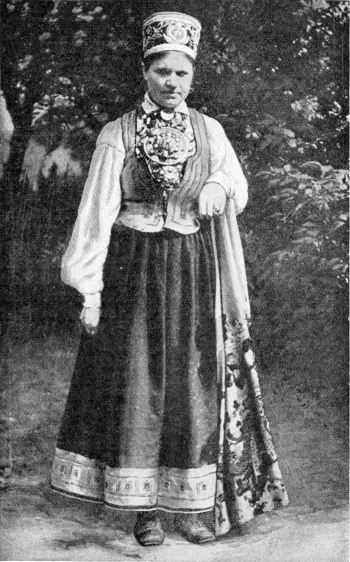
SURVIVAL OF ANCIENT LATVIAN REGALIA
The imposing coronet-shaped headdress and richly-embossed breast buckles figured conspicuously in the full traditional attire of the Letts, and this handsome costume may still be seen in the village of Virga on special festival occasions
Photo, J. Sihlis and Arnold Zahlit, Riga
The old Prussian or Borussian idiom became extinct in the seventeenth century, but the language of the Letts and Lithuanians is even now not unlike that spoken thousands of years ago by their ancestors of the original Aryan stock. Such differences as exist to-day, whether in language or custom, are mainly the outcome of varied historical fortunes and differences of belief—the Lithuanians being still Roman Catholics, whereas the Letts, under Teutonic dominion, threw in their lot early with the Reformation. But it is noticeable that both nations have retained many of the pagan superstitions that were blended with their earliest Christianity, and an elaborate nature-worship is reflected in the folklore still prevailing among the peasantry.
Returning, however, to the Letto-Lithuanian languages, it should be noted that not many years ago they were classified by the Germans as belonging to the Teutonic group, and by the Russians at the same time as belonging to the Slavonic group ; but scholars with deeper knowledge and insight, unbiased, too, by imperialistic designs, came to another conclusion, and established beyond doubt that the Letto-Lithuanian languages belong to a totally distinct family.
Little of the ethnographic material supplied by Greek and Roman writers can be relied upon as actual history; and the historical facts proper, gleaned as they are from diversified sources, provide no connected narrative, but furnish us rather with fitful happenings, chiefly those relating to warfare, of the Cours (Kurs) and Livs, as the people of Courland and Livonia respectively were
 Gallery
Gallery